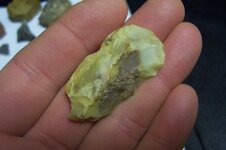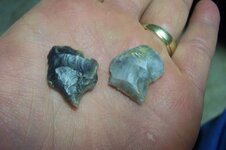rock
Gold Member
Well as some already know I am trying to learn as to hunt a field. I have some questions on it seeing this is the first real field I have ever hunted. Ill describe it for you so you can tell me the best one to hunt. There is 5 total fields at different levels.
#1; One field is by a creek which is probably 30 ft wide. Its winter so no water hunting. It actually goes down hill slightly to the water. Above it is a hill and it doesnt get farmed. Have found some tools throughout.
#2; Is on the right by the creek but has a canal dug on the property that in some spots is 15' deep. Nobody knows who dug it. Havent found anything.
#3; Is to the left of #1 it has creek frontage and that creek leads to a farm with cows. Havent found much but some.
#4; which is the top field on the other side of the hill. Furthest from the water. By the hill and on the hill artifacts. Scrapers, tools, and arrowheads made from quartz cobbles. No large ones and all the tools are small.
#5; I have included this hill as a hunting area not farmed though. No points but have found some of the best colors of lithics in that spot and the best quality. The hill is in the middle of all the fields and you can see the creek from it.
Now my question is which area do you hunters feel might be the best spot to find arrowheads?
I have found no pottery so it might be a early site. Thanks, rock
#1; One field is by a creek which is probably 30 ft wide. Its winter so no water hunting. It actually goes down hill slightly to the water. Above it is a hill and it doesnt get farmed. Have found some tools throughout.
#2; Is on the right by the creek but has a canal dug on the property that in some spots is 15' deep. Nobody knows who dug it. Havent found anything.
#3; Is to the left of #1 it has creek frontage and that creek leads to a farm with cows. Havent found much but some.
#4; which is the top field on the other side of the hill. Furthest from the water. By the hill and on the hill artifacts. Scrapers, tools, and arrowheads made from quartz cobbles. No large ones and all the tools are small.
#5; I have included this hill as a hunting area not farmed though. No points but have found some of the best colors of lithics in that spot and the best quality. The hill is in the middle of all the fields and you can see the creek from it.
Now my question is which area do you hunters feel might be the best spot to find arrowheads?
I have found no pottery so it might be a early site. Thanks, rock
Upvote
0








